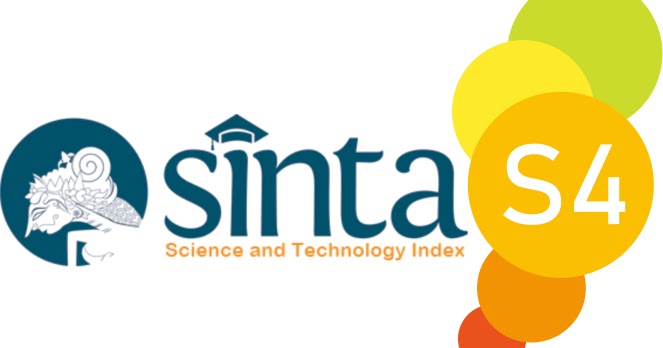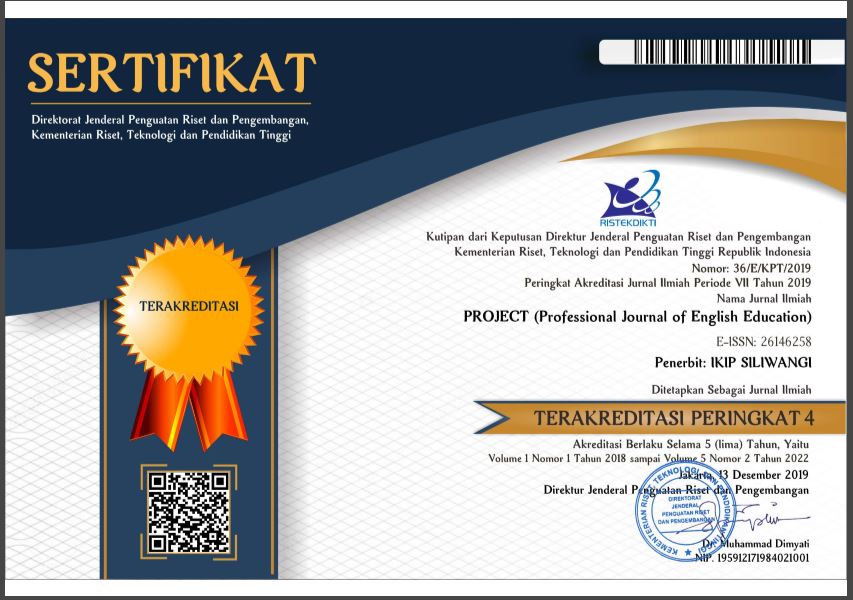Critical Reading and Literacy in EFL Context: A Systematic Literature Review
Abstract
The purpose of this study is to summarize and critically analyze existing empirical research on critical reading and literacy in EFL classroom contexts. The descriptive statistics characterizing the studies (e.g., research designs, participant characteristics, settings) were presented alongside the qualitative content analysis findings results containing the emerging themes, which were arranged sequentially according to their prevalence. The research articles reviewed in this study met the following criteria: (1) peer-reviewed studies, (2) critical reading and literacy in EFL contexts, and (3) published within the last 9 years by using search engine databases (e.g., SINTA, Google Scholars) and reputable journal websites (e.g., journals.sagepub.com, tanfonline.com, link.springer.com). This analytical review revealed three emerging themes of findings informing the outcome of critical reading discourse enhancement in classroom context, critical thinking, and the challenges of integrating critical reading and literacy. The findings of this study should be able to shed light on what has been done thus far and highlight implications for future research and practice regarding critical reading and literacy.
References
Alqatanani, A. K. (2017). Do Multiple Intelligences Improve EFL Students’ Critical Reading Skills? Arab World English Journal (AWEJ), 8(1), 309–321. https://doi.org/https://dx.doi.org/10.24093/awej/vol8no1.22
Al Roomy, M. (2022). Investigating the Effects of Critical Reading Skills on Students’ Reading Comprehension. Arab World English Journal, 13(1), 366–381. https://doi.org/10.24093/awej/vol13no1.24
Aghajani, M., & Gholamrezapour, E. (2019). Critical thinking skills, critical reading and foreign language reading anxiety in Iran context. International Journal of Instruction, 12(4), 219–238. https://doi.org/10.29333/iji.2019.12414a
Arini, Y., & Sulistyarini, I. (2021). Improving Critical Reading Ability, Learning Autonomy, And Learning Participation Through Kahoot! Application. LEKSEMA: Jurnal Bahasa Dan Sastra, 6(1), 91–100. https://doi.org/10.22515/ljbs.v6i1.3477
Carr-Hill, R. A. (Roy A. ., & UNESCO Institute for Statistics. (2008). International literacy statistics : a review of concepts, methodology and current data.
Cresswell W., J. (2014). Research-Design_Qualitative-Quantitative-and-Mixed-Methods-Approaches (4th ed.). Sage.
Damaianti, V. S., Abidin, Y., & Rahma, R. (2020). Higher order thinking skills-based reading literacy assessment instrument: An Indonesian context. Indonesian Journal of Applied Linguistics, 10(2), 513–525. https://doi.org/10.17509/ijal.v10i2.28600
Dumrong, A. (2022). Fostering University Students to Deal with Conflict through Critical Literacy in EFL Reading Class. The Journal of AsiaTEFL, 19(2), 398–413. https://doi.org/10.18823/asiatefl.2022.19.2.1.398
Dündar, E., & Merç, A. (2017). A critical review f research on curriculum development and evaluation in ELT. European Journal of Foreign Language Teaching, 2(1), 136–168. https://doi.org/10.5281/zenodo.437574
Facione, P. a. (1990). Critical Thinking: A Statement of Expert Consensus for Purposes of Educational Assessment and Instruction. Research Findings and Recommendations.
Fairclough, N. (2013). Critical Language Awareness. Routledge.
Halimah, Sumiyadi, Mulyati, Y., & Damaianti, V. S. (2020). Critical Literacy Approach in the teaching of literary appreciation using Indonesian short stories. Indonesian Journal of Applied Linguistics, 10(1), 84–94. https://doi.org/10.17509/IJAL.V10I1.24992
Hashemi, A., & Si Na, K. (2021). The Barriers to the Use of ICT in English Language Teaching : A Systematic Literature Review. Journal of Information and Communication Technologies, 3(1), 77–88. https://dergipark.org.tr/en/pub/bited/issue/63346/841574
Husna, N. (2019). Developing students’ critical thinking through an integrated extensive reading program. TEFLIN Journal, 30(2), 212–230. https://doi.org/10.15639/teflinjournal.v30i2/212-230
Inawati, I., Marbun, C. M., & Pratolo, B. W. (2023). A Systematic Review on Mobile Assissted Language Learning In English Language Teaching. Eltin Journal: Journal of English Language Teaching in Indonesia, 11(2), 131–138.
Janks, H. (2013). Critical literacy in teaching and research. Education Inquiry, 4(2), 225–242. https://doi.org/10.3402/edui.v4i2.22071
Kartika, A. (2020). Indonesian Undergraduate Students’ Perceptions of Project-Based Learning in Critical Reading Class. ELT Worldwide: Journal of English Language Teaching, 7(1), 10. https://doi.org/10.26858/eltww.v7i1.11976
Keefe, E. B., & Copeland, S. R. (2011). What is literacy? the power of a definition. Research and Practice for Persons with Severe Disabilities, 36(3–4), 92–99. https://doi.org/10.2511/027494811800824507
Khoiriyah, E. L., Fithrotunnisa, E. D., & Imtihanudin, D. (2023). The Effect of Collaborative Strategic Reading (CSR) and Critical Reading on Students’ Reading Comprehension. ELT-Lectura, 10(2), 143–154. https://doi.org/10.31849/elt-lectura.v10i2.14938
Ko, M. yun, & Wang, T. F. (2013). EFL Learners’ Critical Literacy Practices: A Case Study of Four College Students in Taiwan. Asia-Pacific Education Researcher, 22(3), 221–229. https://doi.org/10.1007/s40299-012-0013-5
Kusumaningputri, R. (2019). Responding to Islamic religious conducts: Situating morality through critical reading literacy task on cartoons for Indonesian EFL muslim learners. Indonesian Journal of Applied Linguistics, 9(1), 210–218. https://doi.org/10.17509/ijal.v9i1.11381
Larson, K. R. (2014). Critical pedagogy (ies) for ELT in Indonesia. TEFLIN Journal, 25 (1), 122–138. TEFLIN Journal, 25(1), 122–138.
Liang, W., & Fung, D. (2021). Fostering critical thinking in English-as-a-second-language classrooms: Challenges and opportunities. Thinking Skills and Creativity, 39, 100769. https://doi.org/10.1016/j.tsc.2020.100769
Liu, Y. (2017). Critical Literacy Practices in EFL Reading Classroom -An Experimental Study towards Chinese University Students. English Language Teaching, 10(5), 133. https://doi.org/10.5539/elt.v10n5p133
Masduqi, H. (2011). Critical Thinking Skills and Meaning in English Language Teaching. TEFLIN Journal, 22(2), 185–200. http://journal.teflin.org/index.php/journal/article/view/26
Mekuria, A., Bushisho, E. W., & Wubshet, H. (2024). The effects of reading strategy training on students’ reading strategy use and critical reading ability in EFL reading classes. Cogent Education, 11(1). https://doi.org/10.1080/2331186X.2024.2310444
Misa, M. (2023). Multiliteracies Pedagogy: a Case Study of Critical Reading in Elt Classroom By Implementing Situated Practice. English Review: Journal of English Education, 11(2), 489–500. https://doi.org/10.25134/erjee.v11i2.7918
Moghaddam, R. G. (2019). Development of an instrument to measure EFL teachers’ perceptions of reflective teaching. Indonesian Journal of Applied Linguistics, 9(1), 219–230. https://doi.org/10.17509/ijal.v9i1.12826
Nguyen, T. D. T., & Nguyen, H. B. (2023). the Effects of Questioning As Pre-Reading Activity on Efl Grade 12 Students’ Critical Thinking in Reading Classes in Kien Giang, Vietnam. European Journal of English Language Teaching, 8(4), 88–111. https://doi.org/10.46827/ejel.v8i4.4999
Novianti, N., Thomas, A., & To, V. (2020). Addressing challenges in the practice of critical literacy in EFL classrooms: A new framework. Indonesian Journal of Applied Linguistics, 10(1), 206–217. https://doi.org/10.17509/IJAL.V10I1.25049
Nur, S., Butarbutar, R., Ardiningtyas, Y., & Alimuddin, H. (2022). A Systematic Review on Integrating MALL in English Language Teaching. 9(April), 56. https://doi.org/10.26858/eltww.v9i1.30409
Phimphimon, N., Intasena, A., Srimunta, T., & Khantasiri, P. (2024). Improving Critical Reading Abilities in 10th Graders: An Active Learning Approach. International Journal of Learning, Teaching and Educational Research, 23(3), 186–198. https://doi.org/10.26803/ijlter.23.3.10
Putra, T. K., Rochsantiningsih, D., & Supriyadi, S. (2020). Cultural representation and intercultural interaction in textbooks of English as an international language. Journal on English as a Foreign Language, 10(1), 168–190. https://doi.org/10.23971/jefl.v10i1.1766
Sari, D. M. M., & Prasetyo, Y. (2021). Project-based-learning on critical reading course to enhance critical thinking skills. Studies in English Language and Education, 8(2), 442–456. https://doi.org/10.24815/siele.v8i2.18407
Setya, A., Ningrum, B., & Sudarwati, ; Emy. (2022). Is The Test Sensible? Developing A Critical Reading Test for Indonesian EFL Learners. Jeels (Journal of English Education and Linguistics Studies), 9(1), 209–227.
Sriwantaneeyakul, S. (2018). Critical Reading Skills and Translation Ability of Thai EFL Students: Pragmatic, Syntactic, and Semantic Aspects. English Language Teaching, 11(4), 1. https://doi.org/10.5539/elt.v11n4p1
Suarcaya, P., & Prasasti, W. D. (2017). Investigating students’ critical reading: Critical literacy in EFL setting. Electronic Journal of Foreign Language Teaching, 14(2), 220–232.
Surdyanto, A., & Kurniawan, W. (2020). Developing critical reading module using integrated learning content and language approach. Studies in English Language and Education, 7(1), 154–169. https://doi.org/10.24815/siele.v7i1.15098
Umam, A., & Fauziah, Z. N. (2022). Promoting students’ critical thinking skills through project-based learning in Indonesian higher education. JEES (Journal of English Educators Society), 7(1), 110–117. https://doi.org/10.21070/jees.v7i1.1531
Varaporn, S., & Sitthitikul, P. (2019). Effects of multimodal tasks on students’ critical reading ability and perceptions. Reading in a Foreign Language, 31(1), 81–108. http://nflrc.hawaii.edu/rfl
Veliz, L. (2021). In-service teachers’ challenges to implementing an approach to critical thinking and critical reading in Chile. English Language Teaching Educational Journal, 4(3), 161–173. https://doi.org/10.12928/eltej.v4i3.3733
Wahyuni, L. G. E. (2023). The Employment of EFL English Teachers’ Reflective Teaching: Types and Tools for Assessing Oneself. Jurnal Penelitian Dan Pengembangan Pendidikan, 7(1), 67–78. https://doi.org/10.23887/jppp.v7i1.59460
Wallace, C. (1999). Critical Language Awareness: Key Principles for a Course in Critical Reading. Language Awareness, 8(2), 98–110. https://doi.org/10.1080/09658419908667121
Widowati, D. R., & Kurniasih, K. (2018). Critical Reading Skill And its Implication to Speaking Ability In Multicultural Classroom. A Journal of Culture English Language Teaching Literature & Linguistics, 5(2), 18. https://doi.org/10.22219/celticumm.vol5.no2.18-23
Yang, Y. T. C., Chuang, Y. C., Li, L. Y., & Tseng, S. S. (2013). A blended learning environment for individualized English listening and speaking integrating critical thinking. Computers and Education, 63, 285–305. https://doi.org/10.1016/j.compedu.2012.12.012
Yulian, R. (2021). The flipped classroom: Improving critical thinking for critical reading of efl learners in higher education. Studies in English Language and Education, 8(2), 508–522. https://doi.org/10.24815/siele.v8i2.18366
Yunus, M., & Ubaidillah, M. F. (2021). EFL teacher educators’ experiences in teaching critical reading: evidence from Indonesia. Journal on English as a Foreign Language, 11(2), 422–441. https://doi.org/10.23971/jefl.v11i2.3133
Downloads
Published
Issue
Section
License

This work is licensed under a Creative Commons Attribution-ShareAlike 4.0 International License.




